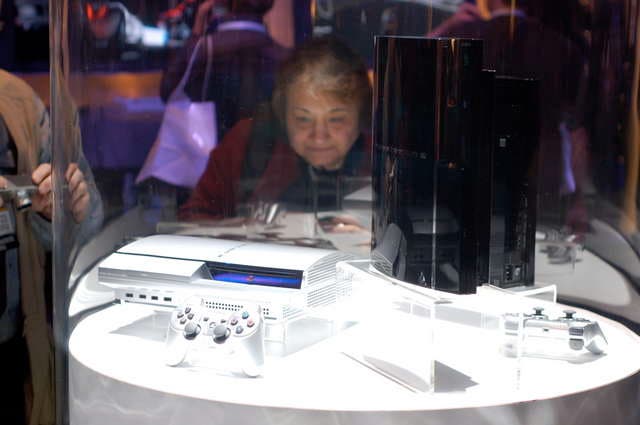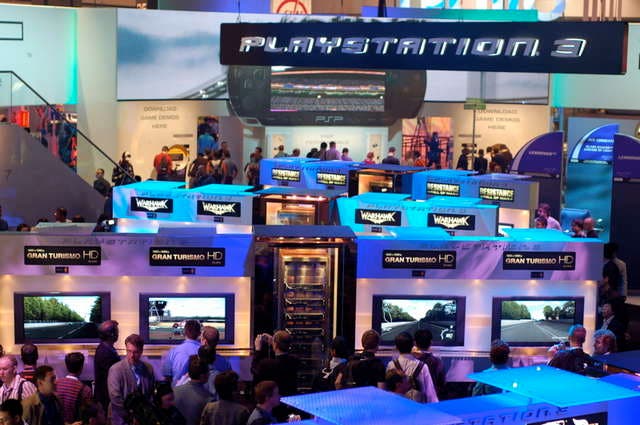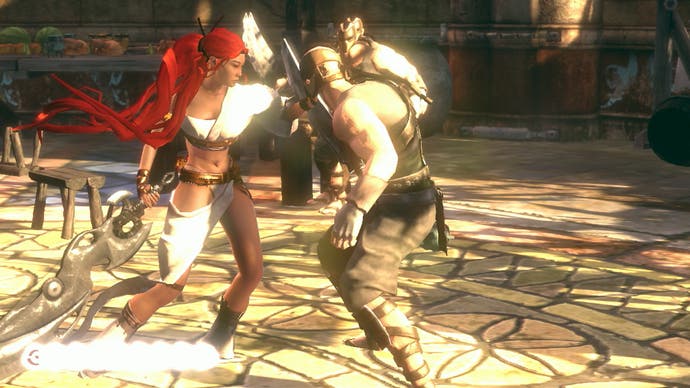PlayStation 3: Are we there yet?
Post-E3: How Sony did.
"The next generation doesn't start until we say it does," says Kaz Hirai. Then again, Sony's E3 conference didn't start when it said it did, so who's counting?
A year ago, Sony stood up in front of the world and outlined a console more powerful than any other, with more forward-thinking technology than any other, and with more big-name games than any other. This year, it did practically the opposite. Gone was the extended technology sermon; instead Hirai name-checked Cell, Blu-ray and RSX to a crowd quite convinced the PS3 was much the same as Xbox 360. Gone was a lot of the forward-thinking technology; ports were shorn from the back of the console, while the new PS3 pad felt like another back-of-the-beermat special from Ken Kutaragi angling after a market Nintendo's had in mind for several years. And while the big-name games were still there, few if any felt close enough to matter.
Still, at least it's more expensive than the others, right?
The addition of motion-sensing to the new controller was one of the big stories. Using the traditional twin-stick Dual Shock design, with slight changes to the analogue sticks and a pair of analogue triggers, it's wireless, like Xbox 360's, and developers told us it lasts about ten hours between charges. A lot of people reacted to the addition of motion sensing by complaining it was very "me too" - Ubisoft Montreal's boss used those exact words - while virtually every developer we spoke to during E3 claimed to have no prior knowledge of it. But while motion sensing has the potential to pay dividends as a differentiator, a more likely result is that third-party publishers will use it as an excuse to co-develop boutique titles for PS3 and Wii, playing to the lowest denominator, the gyroscopic PS3, rather than the more impressive range offered by Wii. Cheers, Sony.

But while the motion-sensor was a jarring addition for some at the time, the loss of rumble functionality is likely to be more keenly felt - or rather not. And that could help drive gamers already enticed by Xbox 360's Achievement system towards multi-platform titles on 360. Precisely what Sony was hoping to avoid this time. Can you imagine SEGA Rally without rumble? Gran Turismo HD felt quite flat without it.
Confusion over technical specifications wasn't merely limited to the loss of rumble, either. The fact that you can use a regular hard disk in the PS3, and therefore save yourself the additional cost Sony's levying on the larger capacity, is better than having to make do without, ala the Xbox 360 Core System. It's not the same kind of dual price strategy. And the loss of Memory Stick ports might not grate too much either. But the loss of HDMI is a PR blunder of considerable proportions, and Kaz Hirai's defence of the cut-down 20GB PS3 model on CNN/Money was slightly comical. "The only difference is HDMI - and at this point, I don't think many people's TVs have that," he said. Not many have 1080p either, Kaz - at least try to sound consistent.
In the last 12 months, a lot of what was said at E3 2005 has been exposed as hot air - not least the unconvincing claims that PS3 game footage was running in real time. But the full extent of what's changed only became clear last week. Where are all the ports on the back of the PS3? Last year's prototype had about a dozen of the blighters. This one had three - with no mention of the dual 1080p output resolution everyone thought was preposterous anyway. Allowing players to look at their F1 car wing-mirror on PSP is hardly the same thing. Meanwhile, digital video content came up in just one passing comment, there was little sign of the impressive multi-panel stuff we saw last year (supposedly one of Cell's key strengths), and on the software front there was no sign of Devil May Cry, MotorStorm, Killzone and others.

The software showcase that-was lacked real gravity - at the conference and at the show. When you compare Sony's E3 2006 line-up, six months out from launch, to Microsoft's E3 2005 line-up six months out from its own, the comparison's a bit more flattering - but who's going to do that? As it stands, Heavenly Sword certainly impressed and WarHawk was promising - albeit largely in concept form - while a host of others provoked more raised eyebrows than pulse-rates. MotorStorm belatedly made it onto the Sony show stand in tech demo format, and Resistance: Fall of Man received some positive write-ups, but demos of games like Eye of Judgement fell a bit flat. Gran Turismo HD certainly ran in 1080p at 60 frames per second, but then it used GT4 assets. Bundle it with the system and people will fawn for a bit, then complain about the lack of rumble, the lack of new content, and the lack of assets to rival those in PGR3, which will have been out for a full year by that point. As it is, we've no idea of GT HD's fate. We may never see it again.
With second and third wave 360 titles to face this Christmas, Sony can't afford to be complacent. A surprise Final Fantasy XIII, Metal Gear Solid or Gran Turismo launch announcement would settle nerves a bit, but otherwise an as-yet unconfirmed line-up known only to include SingStar and Fatal Inertia may have to face the likes of Forza Motorsport 2 and Gears of War on a mature 360 system - likely to have seen software revisions to cope with a heaving Live Marketplace, boasting downloadable Live Arcade games from Japan as well as Western independent developers, and a 12-month catalogue of software that already includes the likes of PGR3 and The Elder Scrolls IV: Oblivion. Most Sony developers we spoke to refused to commit to launch, or even near it, while WarHawk developer Incognito wouldn't either - suggesting that Sony may have a motion-sensing PS3 pad in every PS3 box, but that there won't actually be any games to use it. It's like a third analogue stick in some ways. Right now it's a bit like a third wheel.
With Wii likely to launch at a fraction of the PS3 price, with Metroid and Zelda proposed for launch and Mario a potential latecomer, punters considering their next-gen options may reconsider their PS3 fund's purpose - particularly given that 360 will now host both Halo 3 and Grand Theft Auto IV as soon as they come out. Given the gap between launches, that's likely to have a bearing on how the mass market, at least, greets the next generation. Another round of "target footage", from the likes of Getaway, Eight Days and Naughty Dog's unnamed platform shooter, is not.

Finally, the price - greeted by polite applause. From an industry perspective, the price is fine. Sony will sell out the launch allocation at a high price. It worked for PS2 and PSP. But just as GTAIV appearing on PS3 and 360 simultaneously will weigh on the minds of casual gamers - most of whom probably fancy a go on Halo 3 as well - Sony's latest shameless tax on enthusiasm is likely to weigh on the minds of us lot. We buy every single console when it comes out. You're probably the same. But EUR 600 - even EUR 500 - is more than we're used to paying. The arguments need to be made in games, not with Blu-ray, Cell and RSX. Surely you can only cry "Emotion Engine" once?
As for Blu-ray - we're still wondering whether anybody actually wants it. As one colleague put it, when DVD showed up we were sick of VHS. We're not sick of DVD, whatever the benefits of Blu-ray. Nor, in an era where Sony itself is angling toward digital distribution, does anybody particularly care about improved storage capacity on first-gen titles. When games are big enough to fill Blu-ray discs, surely broadband pipes will be big enough to fit them too?
A lot of people in the days following Sony's conference remarked that it had positioned itself as the 90s Microsoft of the games industry. Where Microsoft is slowly starting to convince people that it wants them to have fun just as much as it wants to make money from games, Sony has gone from peering out over everyone at once with a puffed out chest to standing alone in front of a crowd of angry faces on a giant podium marked "diktat". And some of us are getting revolutionary feelings.
Granted, it's much too early to start talking about what will happen at Christmas - with crucial details like PS3 launch line-up, digital download pricing, game pricing and Nintendo's plans to come. But where Microsoft reacted to the criticism of its actions last year, Sony hasn't. Unless you reckon they borrowed the pad idea from Nintendo's TGS and the pricing from Microsoft, of course. There were certainly good things to come out of Sony's conference - a firm launch date, a promise to deliver six million units by next April, some sensible revisions to the pad, that reassertion of full backwards-compatibility and a free online service, Singstar the way we all wanted it in the first place, from day one, and games that look healthier six months out than Microsoft's did at the comparable point. But the tenor of Sony's conference was still quite bleak - and the sense was that it did more harm than good. Kaz Hirai can bluster all he wants, but you can't move the goalposts if you're not on the field.
Stay tuned for more E3 analysis later this week.








